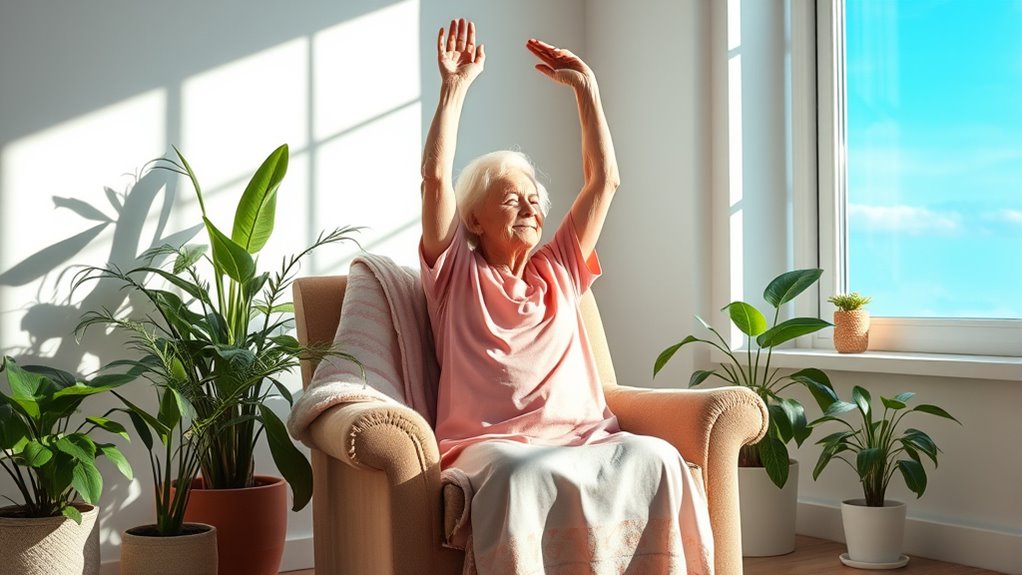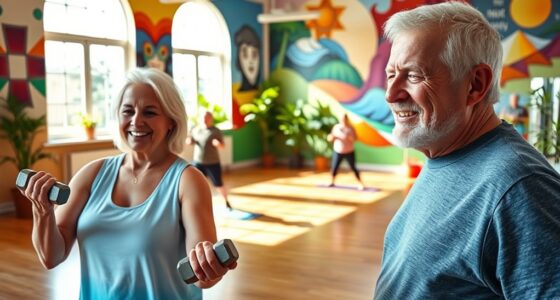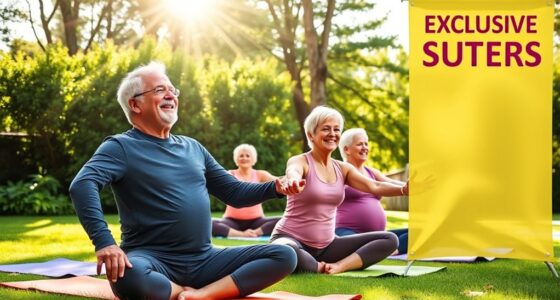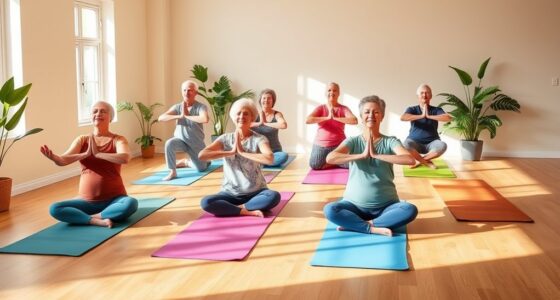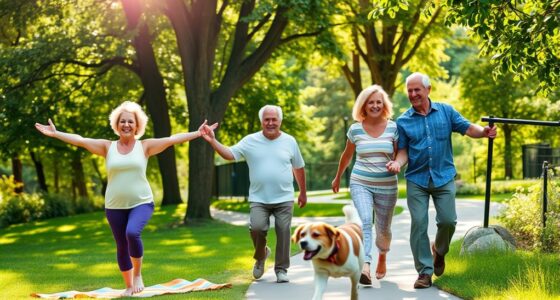Chair yoga’s a fantastic way for you to stretch and relax in just minutes, offering numerous benefits for your body and mind. With gentle warm-up stretches, upper body mobility exercises, and deep breathing techniques, you can easily enhance your flexibility and reduce stress. Incorporating forward bends and twists will improve spinal mobility. By making chair yoga a part of your daily routine, you’ll promote overall well-being—there’s so much more to discover about this calming practice!
Key Takeaways
- Chair yoga alleviates back pain and promotes relaxation, making it ideal for seniors seeking stress relief in just a few minutes.
- Simple warm-up techniques like pelvic tilts and gentle stretches prepare the body for movement and enhance overall mobility.
- Incorporate deep breathing with arm movements to improve oxygen flow and promote mindfulness during practice.
- Seated twists and forward bends can be done easily to enhance spinal flexibility and reduce tension in the back and neck.
- Set aside a few minutes daily for chair yoga to experience lasting benefits in flexibility, posture, and mental well-being.
Benefits of Chair Yoga for Seniors
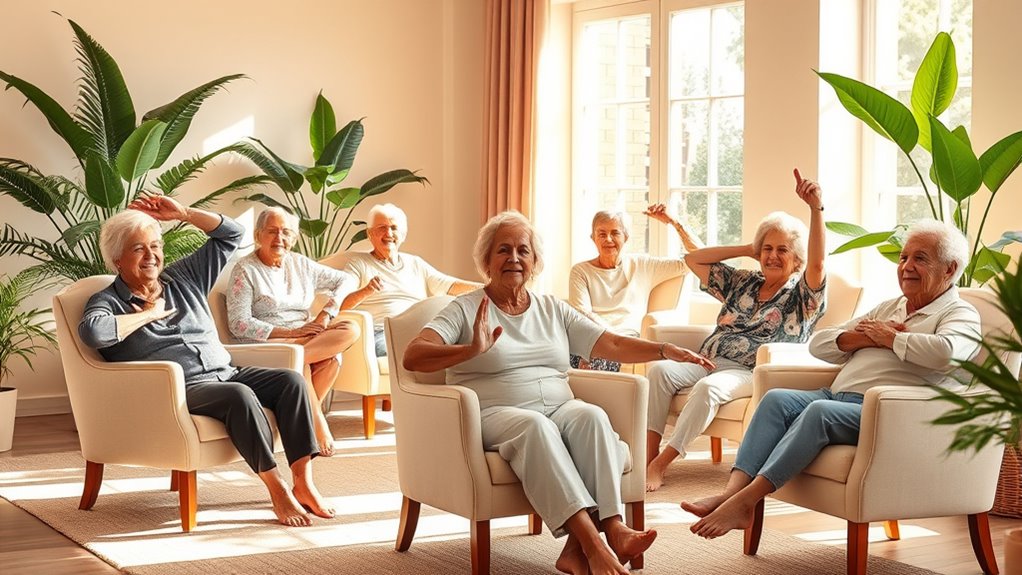
Chair yoga offers numerous benefits for seniors, making it an excellent choice for those looking to stay active and healthy. One major advantage is its ability to alleviate back pain, which many seniors experience due to prolonged sitting. Additionally, practicing chair yoga can help reduce stress levels, promoting a sense of calm and relaxation. Engaging in physical activity, such as chair yoga, can also support emotional readiness and overall mental health. Furthermore, maintaining good posture during these exercises can enhance your overall well-being. Regular practice can also boost cognitive function, which is crucial for seniors at risk of cognitive decline.
By enhancing flexibility and mobility, chair yoga helps you maintain independence and reduces the risk of falls. This low-impact workout is easily adaptable for those with joint issues or arthritis, ensuring everyone can participate.
Regular practice also improves posture and spinal health, combating discomfort from sedentary lifestyles. Furthermore, the incorporation of deep breathing techniques boosts lung capacity and respiratory function, contributing to your overall well-being.
Embracing chair yoga can truly transform your daily life for the better. Engaging in this practice can also promote personal growth techniques that lead to enhanced self-awareness and overall wellness.
Essential Warm-Up Stretches
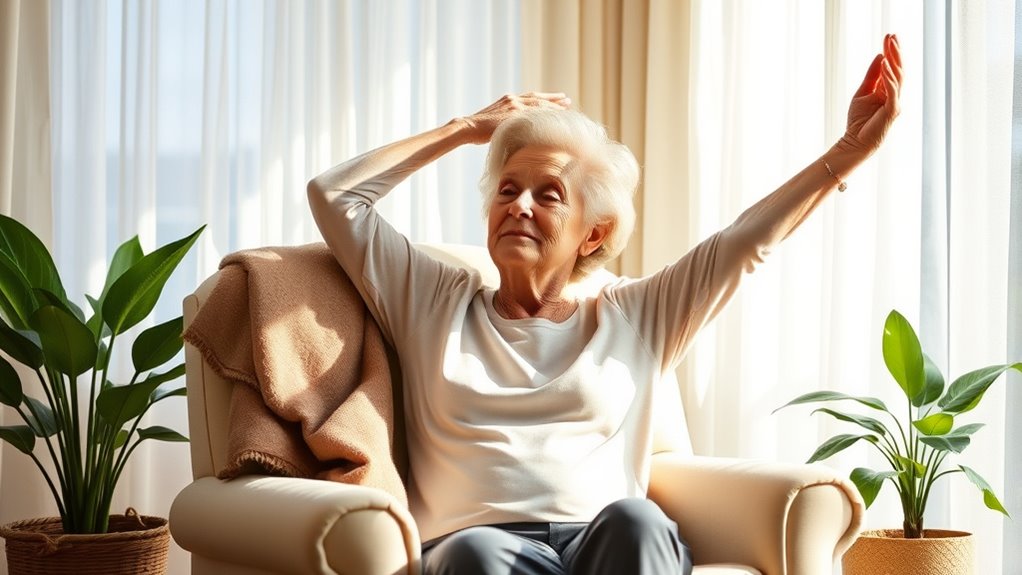
To get the most out of your chair yoga session, start with pelvic tilts to engage your core and improve your posture. As you move through stretches like cat-cow and arm raises, focus on your breath to enhance each movement. These essential warm-up stretches not only prepare your body but also promote relaxation and mindfulness. Incorporating educational toys into your routine can further enhance your overall well-being by stimulating cognitive engagement. Additionally, practicing mindfulness can support emotional and psychological growth, contributing to your lifespan perspective on health and wellness. Engaging in regular physical activity can significantly improve your overall health, ensuring that you remain active and vibrant as you age. Research shows that gentle methods in physical activities can also support emotional needs, promoting a holistic approach to well-being. Furthermore, integrating digital creativity into your daily activities can inspire a more engaged and innovative mindset.
Core Engagement Techniques
While warming up, engaging your core is essential for enhancing stability and supporting your spine, especially as you age or if you have joint issues. To keep your core engaged, try pelvic tilts while seated. This movement helps activate your abdominal muscles, promoting awareness and control. Incorporate cat-cow stretches and body rolls to warm up your spine while encouraging core engagement. Additionally, effective reduction of allergens can improve your overall comfort during these stretches. Creating a supportive home environment for elderly individuals can further enhance their well-being and ease of movement. Engaging in fitness programs tailored to all age groups can provide additional benefits for seniors. Regular physical activity, such as yoga, can also improve digestive health and overall wellness. These movements not only improve flexibility and mobility but also help you maintain proper posture. As you practice these techniques, remember to breathe deeply and steadily; this will reduce stress and enhance your overall relaxation during the workout. Additionally, consistent core engagement can lead to better posture and a lower risk of injury in your daily activities. Consistent core engagement can lead to better posture and a lower risk of injury in your daily activities.
Breath-Controlled Movements
Incorporating breath-controlled movements into your warm-up stretches can greatly enhance your chair yoga experience. By focusing on deep, rhythmic breathing, you promote better oxygen flow to your muscles, which aids flexibility and reduces tension.
For instance, as you raise your arms, inhale deeply, and exhale while bending forward. This connection between breath and movement helps you stay mindful and engaged. Practicing these movements can also support your journey towards embracing burnout recovery, allowing you to replenish your energy levels. Additionally, integrating visualization techniques can help you focus on your desired outcomes during practice. Automation technologies in other fields, such as intelligent tutoring systems, have been shown to improve engagement and learning outcomes, which highlights the potential benefits of structured practices like chair yoga. Regular practice of breath control can also enhance self-worth, encouraging you to appreciate the small victories in your wellness journey.
Practicing breath control during exercises like pelvic tilts and cat-cow stretches stabilizes your core and improves posture. Regularly incorporating these breath-controlled movements into your routine can lead to increased relaxation and stress reduction, making chair yoga an effective practice for enhancing your overall well-being. Additionally, understanding shared assets and liabilities during life transitions can further enhance your mental clarity and focus during practice.
Enjoy the benefits of breath and movement together!
Upper Body Mobility Exercises
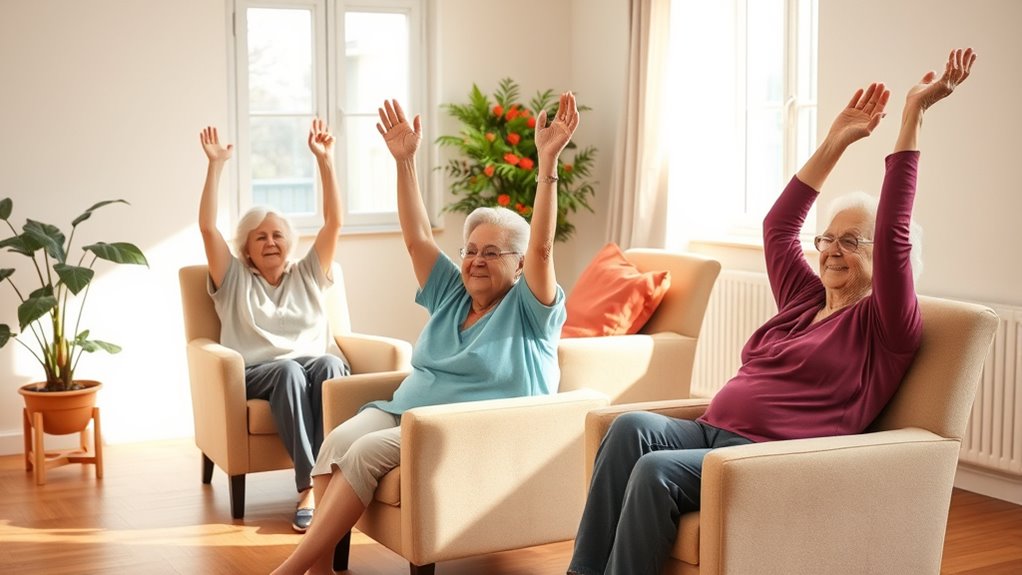
Upper body mobility exercises are key to enhancing flexibility and strength in your shoulders and arms. You can start with seated arm stretches that engage your core while promoting better posture. Incorporating effective relaxation techniques can further reduce tension in the upper body, making these movements even more beneficial. Adding these simple movements to your routine can make a significant difference in your daily comfort and confidence. Regular practice of such exercises can also lead to improved overall physical health, which is essential for maintaining mobility as you age. Additionally, staying well-hydrated can greatly support your skin health during physical activities. Moreover, engaging in these exercises regularly can help you avoid overspending on healthcare costs associated with physical ailments. Furthermore, maintaining proper hydration is crucial in preventing fatigue during physical activities, ensuring that you remain energized and focused.
Seated Arm Stretches
Seated arm stretches are a fantastic way to enhance your upper body mobility, especially if you’re looking for gentle exercises that fit into a daily routine. These stretches are great for seniors, promoting flexibility in the shoulders and arms while reducing tension in the upper back.
Here are some common seated arm stretches you can try:
| Stretch Name | Benefits |
|---|---|
| Raise Arms Overhead | Increases shoulder flexibility |
| Cross Arms in Front | Stretches upper back and chest |
| Wrist Rotations | Improves wrist mobility |
| Side Arm Reaches | Enhances lateral flexibility |
Incorporate deep breathing during these stretches to enhance relaxation and overall well-being. Enjoy the benefits of improved mobility and stress relief!
Core Engagement Techniques
While you practice upper body mobility exercises, engaging your core is essential for stabilizing your spine and promoting better posture. Techniques like pelvic tilts and cat-cow stretches effectively activate your core, enhancing body awareness and helping you shift smoothly between movements.
Incorporating seated arm stretches, such as raising your arms overhead and performing side stretches, allows for improved shoulder flexibility while maintaining core engagement. Controlled movements, like cross-body arm stretches and seated twists, focus on core stability while gently challenging your upper body, boosting mobility and strength.
Remember to breathe deeply and rhythmically during these exercises; this not only enhances relaxation but also supports core engagement, amplifying the benefits of each stretch and movement.
Forward Bends and Twists
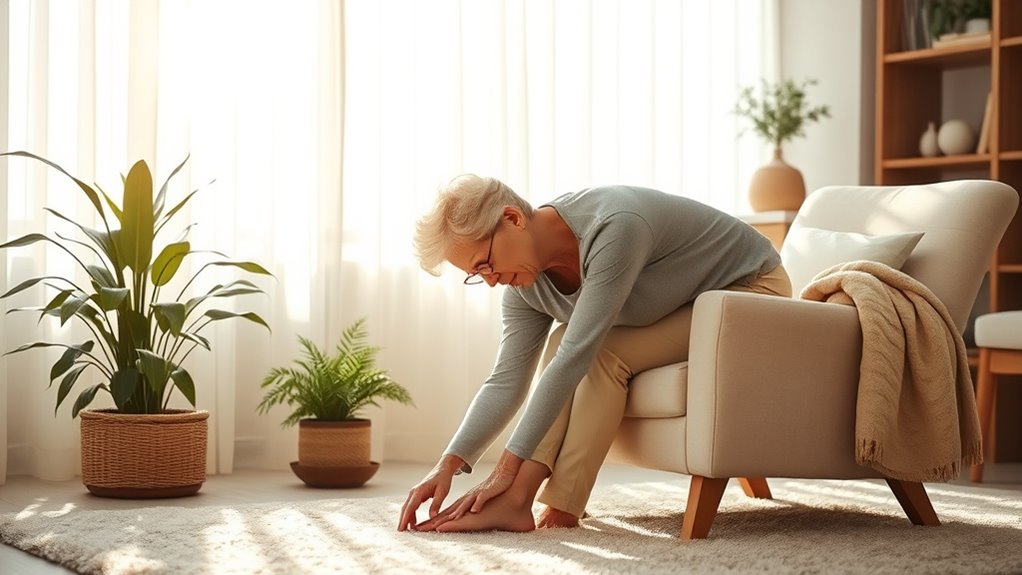
As you engage in forward bends and twists, you’ll discover how these movements can enhance your flexibility and relieve tension. Forward bends involve hinging at the hips while keeping your back straight, stretching your hamstrings and lower back effectively. Incorporating gentle head movements during these bends can further release neck tension. Seated twists improve spinal mobility and flexibility, stretching your shoulders and alleviating stiffness. Practicing these movements mindfully promotes relaxation and deepens the stretch. Remember to repeat forward bends and twists on both sides for balanced flexibility and strength.
| Movement Type | Benefits |
|---|---|
| Forward Bends | Stretch hamstrings and lower back |
| Gentle Head Movements | Release neck tension |
| Seated Twists | Improve spinal mobility |
| Mindful Changes | Enhance relaxation |
| Balanced Practice | Guarantee equal flexibility and strength |
Deep Breathing Techniques
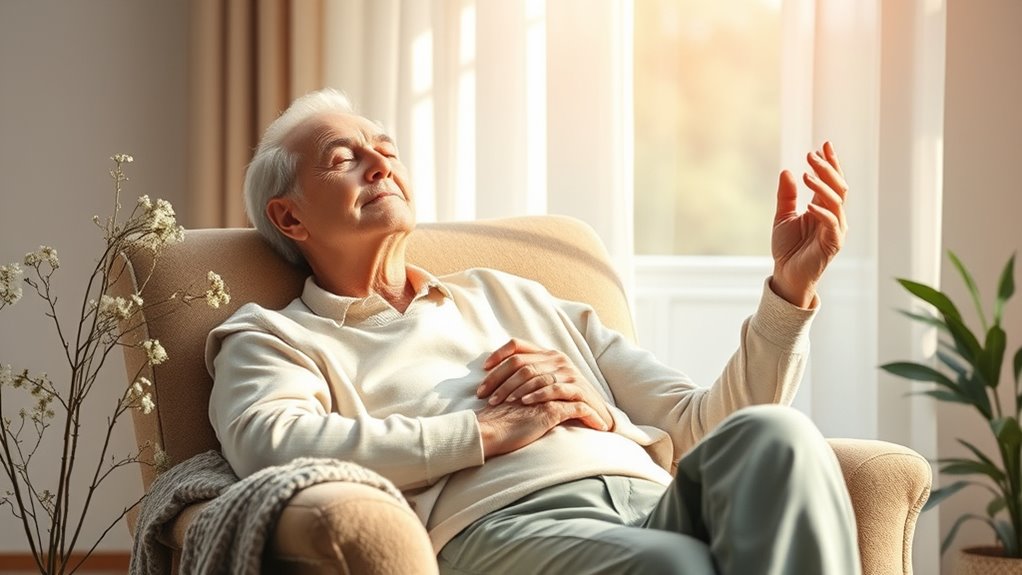
Deep breathing techniques can transform your chair yoga practice by promoting relaxation and reducing stress.
Start by inhaling deeply through your nose, filling your lungs completely. Hold for a moment, then exhale slowly through your mouth. This rhythmic breathing enhances oxygen flow, which is especially beneficial for seniors and anyone dealing with joint issues like arthritis.
Inhale deeply through your nose, exhale slowly through your mouth, enhancing oxygen flow and easing joint discomfort.
As you breathe, focus on relaxing your lower back, allowing tension to melt away. Practicing this technique can help lower blood pressure and improve cardiovascular health.
By concentrating on your breath, you cultivate mindfulness, keeping you present and enhancing your overall yoga experience.
Regular deep breathing not only fosters emotional resilience but also sharpens mental clarity, supporting your sense of well-being.
Incorporating Chair Yoga Into Your Routine

After mastering deep breathing techniques, you can seamlessly incorporate chair yoga into your daily routine.
Start by setting aside just a few minutes each day—go ahead and choose a time that works best for you, whether it’s in the morning or during a break.
This gentle practice enhances flexibility and relaxation, making it perfect for seniors or anyone with limited mobility.
Regular chair yoga sessions can help reduce stress and improve mental well-being through mindful movements.
Plus, you’ll notice improvements in joint health and core strength over time.
You can easily integrate these exercises at home or in a community setting, ensuring you maintain fitness and stability without much effort.
Enjoy the journey to a healthier you!
Encouraging Community and Connection

While you focus on your chair yoga practice, it’s important to recognize the incredible benefits of community and connection. Joining group sessions allows you to engage socially, fostering emotional well-being.
As you bend slightly and share your experiences, you’ll find others who face similar fitness goals and challenges. This shared journey creates a supportive atmosphere where feedback and tips flow freely, enhancing motivation and commitment.
Whether you attend virtual or in-person classes, building relationships while improving your health is fundamental. By promoting interaction through shared experiences, you empower yourself and others on this wellness journey.
Embrace the connections you make; they’re just as significant to your practice as the stretches themselves.
Frequently Asked Questions
Does Chair Yoga for Seniors Really Work?
Yes, chair yoga for seniors really works! It enhances flexibility, balance, and overall well-being, making it a great choice for those with limited mobility.
You’ll likely notice reduced stress and anxiety through deep breathing and relaxation techniques. Regular practice can alleviate joint pain and stiffness, particularly if you have arthritis.
Plus, it boosts mood and cognitive function, contributing to a better quality of life. So, give it a try—you won’t regret it!
Which Yoga Is Best for Senior Beginners?
When you’re exploring yoga options as a senior beginner, gentle styles like Hatha or restorative yoga can be delightful.
These forms invite you to embrace relaxation while enhancing flexibility and strength.
You’ll find that chair yoga is particularly accommodating, allowing you to stretch and breathe deeply without the worry of falling.
Enjoy the soothing movements and focus on your well-being, knowing you’re taking meaningful steps toward a healthier, more balanced life.
Can You Lose Weight Doing Chair Yoga for Seniors?
Yes, you can lose weight doing chair yoga. While it mightn’t burn a ton of calories, chair yoga promotes gentle movement and flexibility, encouraging you to be more active overall.
It helps build strength and improve muscle tone, boosting your metabolism. Plus, it reduces stress and can curb emotional eating, which often hinders weight loss.
How Often Should Seniors Do Chair Yoga?
You should aim to practice chair yoga at least 2-3 times a week.
This frequency helps you maintain flexibility and strength while enhancing your overall well-being.
Engaging in sessions for 20-30 minutes can improve your mobility and reduce discomfort from joint issues.
Consistency not only promotes relaxation but also lowers stress levels, making chair yoga a valuable addition to your routine for better physical and mental health.
Conclusion
Just like a sturdy tree bends gently in the wind, you too can find strength and flexibility through chair yoga. By embracing these simple stretches and breathing techniques, you cultivate resilience in both body and spirit. As you weave this practice into your daily routine, remember that each moment spent in mindfulness deepens your roots, fostering connections with yourself and others. So, take a seat, breathe, and let your inner garden flourish, one stretch at a time.
